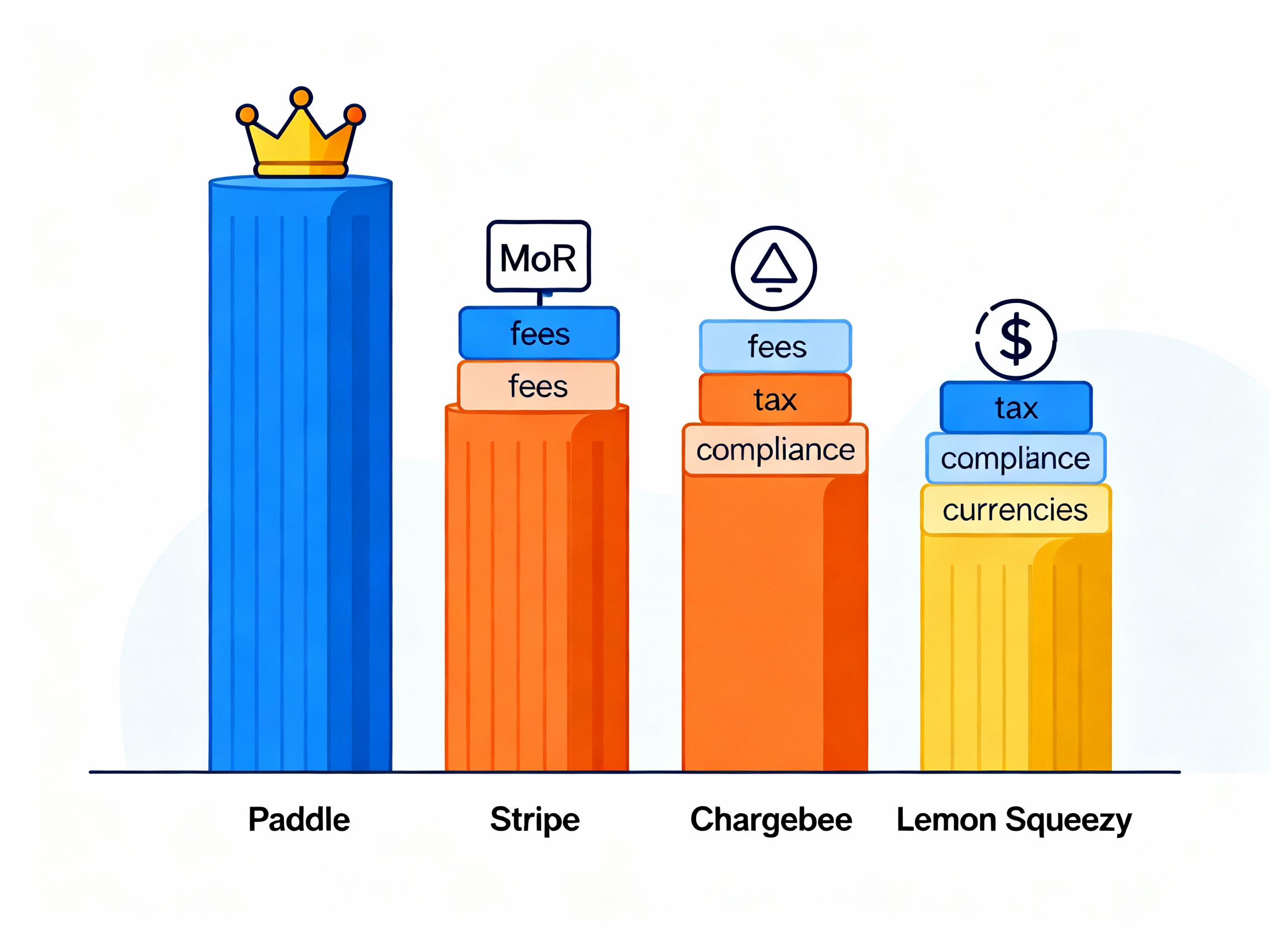
For growing SaaS companies, especially those expanding internationally, choosing a payment infrastructure is a strategic decision. The key question arises: build your own complex ecosystem or buy a ready-made all-in-one solution? Paddle offers the latter path, acting as the Merchant of Record (MoR).
What is MoR and why is it important?
Merchant of Record is a legal entity that acts as the seller to the end customer on your behalf. In practice, this means Paddle takes full responsibility for the transaction:
Tax responsibility: Paddle automatically calculates, collects, and, critically, pays taxes (VAT, GST, sales tax) in more than 100 jurisdictions worldwide. When using processors like Stripe, this obligation—including registration, reporting, and tracking legislative changes—falls entirely on you.
Fraud and chargeback management: Paddle independently analyzes transactions for fraud, combats unjustified refunds, and protects you from related financial losses.
Legal and regulatory compliance: The platform ensures compliance with PCI-DSS, GDPR, SOC 1 & SOC 2 standards, taking on all obligations to payment systems and regulators.
Thus, MoR is not just a way to accept payment, but a partner that relieves you of a huge amount of administrative, legal, and tax burden, allowing you to focus on product development and marketing.
Transparent pricing for a ready-made solution: what's included in Paddle's commission
Paddle uses a simple and transparent Pay-as-you-go pricing model:
Rate: 5% + $0.50 per successful transaction through Checkout.
What's included: Unlike models with monthly fees or hidden charges, this commission covers all platform features:
High-performance and localized checkout.
Subscription management (including migration without additional fees).
Global payments with support for multiple currencies and methods.
Automatic tax compliance (calculation, collection, and payment).
Fraud protection and chargeback management.
Detailed analytics and reporting.
Customer support for billing issues.
Custom rates: For enterprises with large volumes, as well as for products priced below $10, custom rates are available.
At first glance, the commission is higher than basic payment processors. However, this price is all-inclusive. In comparison, using Stripe to create a similar service stack (subscriptions, taxes, fraud management) can cost a total of 4-8% per transaction, while administration and responsibility remain with you.
Global reach and technical capabilities
Paddle is designed for international sales of digital products from day one:
Geography: Sales in more than 200 countries.
Currencies and payment methods: Support for more than 30 currencies and all major payment methods, including credit cards, PayPal, Apple Pay, and local payment options.
Localization: Checkout automatically adapts to the language, currency, and popular payment methods of the buyer's region, increasing conversion.
API and integration: Paddle provides a full-featured REST API and official SDKs for Go, Node.js, PHP, and Python, simplifying integration for developers. Postman collections and templates for a quick start are also available.

Comparing Paddle with competitors: Strategic choice
To understand how well Paddle suits you, it needs to be compared with alternatives. The main divide is between all-in-one Merchant of Record (MoR) like Paddle and Payment Service Providers (PSP) like Stripe, which require building your own infrastructure.
Here is a detailed comparison by key parameters:
| Parameter | Paddle (MoR) | Stripe (PSP) | Chargebee | Lemon Squeezy (MoR) |
|---|---|---|---|---|
| Main model | Merchant of Record — all-in-one platform. | Payment processor — requires additional services. | Subscription billing on top of PSP (often Stripe). | Merchant of Record, similar to Paddle, but for small businesses and creators. |
| Key advantage | Complete removal of operational and tax burden. | Maximum control, flexibility, and rich ecosystem. | Deep customization for complex billing models. | Ease of launch and built-in email marketing. |
| Commission | 5% + $0.50 per transaction (all-inclusive). | ~2.9% + $0.30 (payments only), subscriptions, taxes, etc. — paid separately. | Monthly subscription (from $250/month) + % of turnover + payment processor commission. | 5% + $0.50 per transaction (similar to Paddle). |
| Tax compliance | Automatic tax collection and payment in 100+ jurisdictions. | Provides tools (e.g., TaxJar), but registration and payment are the seller's responsibility. | Automation through integrations, but responsibility on the seller. | Automatic global tax compliance. |
| Currency/country support | 200+ countries, 30+ currencies. | 195 countries, 135+ currencies. | Depends on the chosen payment processor (usually Stripe). | 135+ countries, 20+ payment methods. |
Key takeaways from the comparison
Choosing between Paddle and Stripe is a choice between convenience and control. Paddle, for a fixed commission, frees you from tons of routine. Stripe is initially cheaper, but to achieve comparable functionality, you will need to integrate and pay for subscription, tax, fraud management services yourself, as well as bear administrative and legal risks. The Total Cost of Ownership may be higher.
Paddle vs. Chargebee: Chargebee is not MoR but a powerful subscription management system that works on top of your payment processor. It's a great choice if you need maximum flexibility for complex billing models (per-second billing, tiered plans) and are willing to pay for the development and support of this ecosystem. Paddle offers a less flexible but ready-to-use "boxed" product.
Who Paddle is for: Final selection guide
Based on the analysis, here are the final recommendations.
Paddle is the ideal choice for:
Startups and growing teams that lack resources for maintaining lawyers, tax consultants, and payment system developers.
Companies focused on global expansion from day one. Paddle allows you to almost instantly start selling in most countries worldwide with full tax compliance.
Projects where minimizing operational costs is more important than an absolutely custom payment process.
You should consider alternatives (Stripe, Chargebee) if:
Your product requires extremely complex and non-standard billing models that Paddle does not support.
Your business model is sensitive to a 1.5-2% difference in commissions at high volumes, and you are ready to take on all associated administrative burdens.
You critically need maximum control over every aspect of the payment experience, including deep checkout customization.
Conclusion
Paddle is not just a tool for accepting payments. It is a strategic partner for SaaS businesses that takes on all the "invisible" but critically important work related to global sales. The higher commission is essentially a fee for the ability to focus all resources on product development and marketing, without being distracted by legal and tax complexities.
For young and ambitious SaaS companies, especially in the B2B segment, this platform can become a powerful growth accelerator that pays for itself with freed-up time and reduced risks.
I hope this detailed analysis was helpful to you. If you have any questions about specific integration nuances or features of working with any of the services, feel free to ask.

Leave a comment
Comment